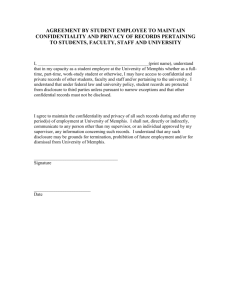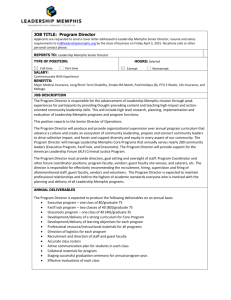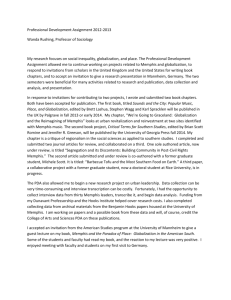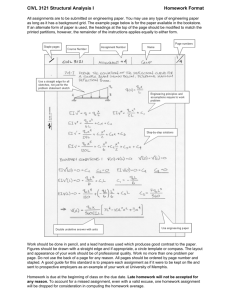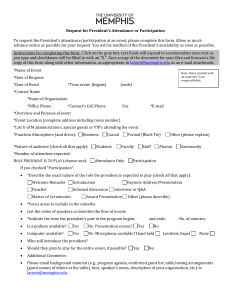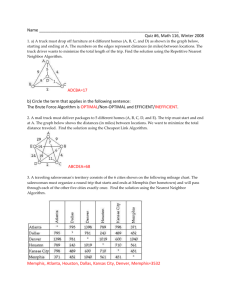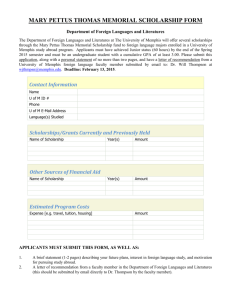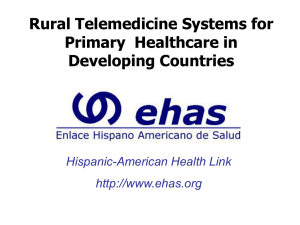August 2005 - University of Memphis
advertisement
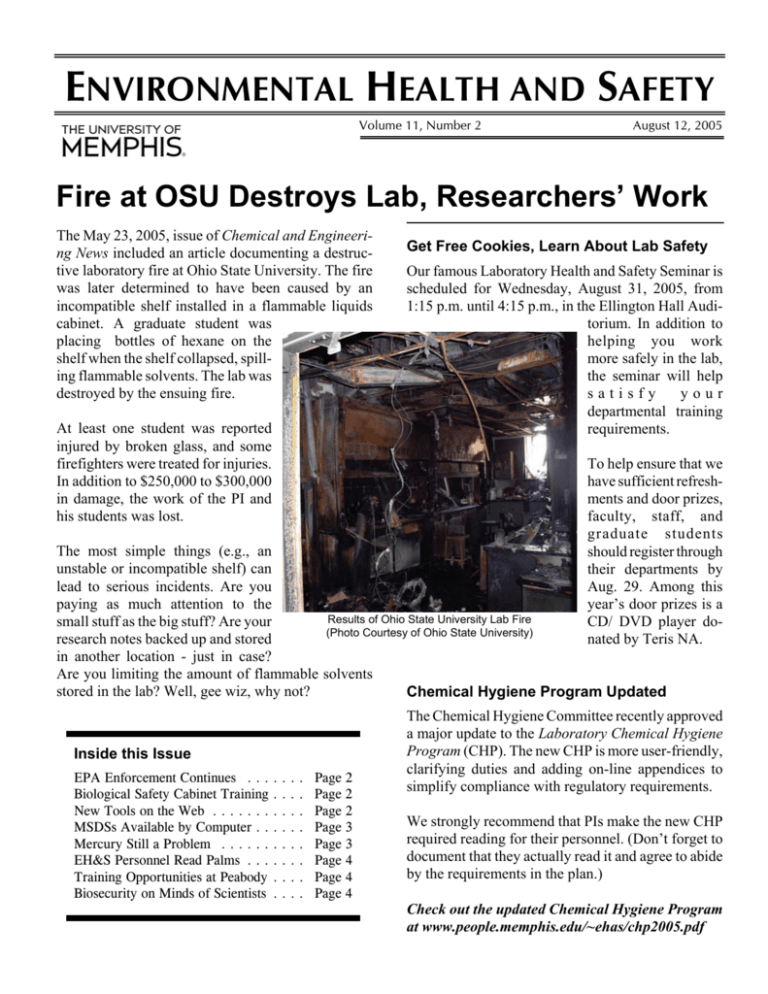
ENVIRONMENTAL HEALTH AND SAFETY Volume 11, Number 2 August 12, 2005 Fire at OSU Destroys Lab, Researchers’ Work The May 23, 2005, issue of Chemical and Engineering News included an article documenting a destructive laboratory fire at Ohio State University. The fire was later determined to have been caused by an incompatible shelf installed in a flammable liquids cabinet. A graduate student was placing bottles of hexane on the shelf when the shelf collapsed, spilling flammable solvents. The lab was destroyed by the ensuing fire. At least one student was reported injured by broken glass, and some firefighters were treated for injuries. In addition to $250,000 to $300,000 in damage, the work of the PI and his students was lost. Get Free Cookies, Learn About Lab Safety Our famous Laboratory Health and Safety Seminar is scheduled for Wednesday, August 31, 2005, from 1:15 p.m. until 4:15 p.m., in the Ellington Hall Auditorium. In addition to helping you work more safely in the lab, the seminar will help satisfy your departmental training requirements. To help ensure that we have sufficient refreshments and door prizes, faculty, staff, and graduate students should register through their departments by Aug. 29. Among this year’s door prizes is a CD/ DVD player donated by Teris NA. The most simple things (e.g., an unstable or incompatible shelf) can lead to serious incidents. Are you paying as much attention to the Results of Ohio State University Lab Fire small stuff as the big stuff? Are your (Photo Courtesy of Ohio State University) research notes backed up and stored in another location - just in case? Are you limiting the amount of flammable solvents stored in the lab? Well, gee wiz, why not? Chemical Hygiene Program Updated Inside this Issue EPA Enforcement Continues . . . . . . . Biological Safety Cabinet Training . . . . New Tools on the Web . . . . . . . . . . . MSDSs Available by Computer . . . . . . Mercury Still a Problem . . . . . . . . . . EH&S Personnel Read Palms . . . . . . . Training Opportunities at Peabody . . . . Biosecurity on Minds of Scientists . . . . Page 2 Page 2 Page 2 Page 3 Page 3 Page 4 Page 4 Page 4 The Chemical Hygiene Committee recently approved a major update to the Laboratory Chemical Hygiene Program (CHP). The new CHP is more user-friendly, clarifying duties and adding on-line appendices to simplify compliance with regulatory requirements. We strongly recommend that PIs make the new CHP required reading for their personnel. (Don’t forget to document that they actually read it and agree to abide by the requirements in the plan.) Check out the updated Chemical Hygiene Program at www.people.memphis.edu/~ehas/chp2005.pdf EPA Enforcement Continues Biological Safety Cabinet Training Available The most recent Environmental Protection Agency (EPA) enforcement action against colleges and universities has resulted in a proposed penalty of $107,165 against the Maine College of Art. EPA alleges that the college “failed to properly determine if wastes were hazardous wastes, thus putting the school’s staff and students at risk.” EH&S recently purchased a video entitled “Safe Use of Biological Safety Cabinets” and a CD-ROM based training program called “Biological Safety Cabinets A Web-based Training Program.” We believe that every person using a BSC should either see the video or complete the CD-ROM based training. These training aids are available for your use at no charge. According to EPA, waste glaze and floor sweepings were placed in the trash or washed down the drain; and acid pickling solutions were poured down the drain; cans of paint, metal blasting debris, paint thinners, fluorescent tubes, and computer monitors were improperly managed. Quite a list of violations. Are you taking advantage of the many free training resources available through EH&S? New Lab Safety Specialist is Here to Help Katherine Miller (photo at left) is our new Laboratory Safety Specialist. Katherine has a Bachelor of Science degree; her areas of study emphasis were microbiology and German. She comes to The U of M with several years of experience as a chemist for a hazardous waste disposal contractor. In related news, the Maine Katherine Miller, Rene de Cart (part of the U of M hood Community College System test cart), and Kerry Alfred of ECT take a light hearted agreed to pay $126,600 to break from testing fume hoods. settle alleged hazardous waste violations at two of its campuses. EPA regional In addition to recently completing some specialized administrator Robert W. Varney said of the violations, lab safety training at the Eagleson Institute in Maine, “The problems at these two campuses were severe Katherine has been busy testing fume hoods, inand put students and staff at risk.” Among the items specting labs, and performing related tasks. Look for cited by EPA were storage of old chemicals that had Katherine in your lab soon, or call her at 2740. become unstable explosives. Hood Test Backlog Reduced New Tools on Our Web Site Due to turnover of personnel, there has been a significant backlog of fume hoods that needed testing. In order reduce this backlog, the Laboratory Safety Specialist worked with Exposure Control Technologies (ECT) to implement a marathon hood testing program in June. Although our web page still has the same old look at www.people.memphis.edu/~ehas, we have been adding and updating lots of things to help you. The “Downloads” section now features a new bloodborne pathogens incident report form, a laboratory specific standard operating procedure template, an updated laboratory inspection checklist, and a hazard assessment guide for personal protective equipment. And if you have not noticed, the Unwanted Chemical Declaration Form has been updated with some spiffy new features like drop down selection lists. Check ‘em out. Environmental Health and Safety We hope to have all hood testing up-to-date by the time you read this article. However, if your fume hood does not have a sticker indicating that it was tested within the past 12 months, please call; we will make sure that it is tested. Page 2 August 12, 2005 MSDSs Available on Your Computer Mercury Still a Problem on Campus After decades of Material Safety Data Sheets (MSDSs) being hidden away in file cabinets, our collection of laboratory chemical MSDSs is available via the University intranet. Using Netscape or Internet Explorer (IE), type in http://chim.memphis.edu/msd s-find. Once the log-in screen appears in your browser, enter your UUID and password (for IE, precede your UUID with uom\). You will initially be prompted to install a viewer for the ImageWave system. Once the viewer is installed, you can search for the MSDS on your favorite chemical. If you can’t log in, make sure that you have active directory turned on by going to http://iam.memphis.edu. It has been approximately 8 years since most of your departments participated in the thermometer exchange program and made a commitment to eliminate or significantly reduce the amount of mercury in your labs and shops. Even with that commitment, we continue to spend thousands of dollars each year for disposal of waste mercury. Mercury continues to be our most commonly spilled chemical. In 2004 the University spent $10,000 managing just one mercury spill - that’s almost 10% of the $114,951.69 total hazardous waste generation cost for the year! Please remember that mercury-containing devices are to be purchased only when no suitable alternative exists. And don’t forget to inspect unwanted equipment for hidden sources of mercury such as switches and batteries that should be removed before disposal. Please note that this system does not replace the need to maintain paper copies of MSDSs that are readily available to employees; the ImageWave system is designed to supplement the paper copies by allowing rapid retrieval of information. Although the system currently only contains laboratory chemicals, we are slowly adding chemical products used by Physical Plant and other departments. Let’s all do our part to eliminate unneeded mercury. Explosion Rocks UC-Riverside Stockroom An explosion and fire occurred during early May in a University of California at Riverside organic chemistry stockroom. Two students were injured by flying glass. The explosion was caused by some Tollen’s test reagent. Tollen’s is known to be susceptible to instability on storage, leading to spontaneous explosions. EH&S is the official custodian of all MSDSs for the University. If you receive an original MSDS directly from a vendor, make sure to make a copy for yourself and send us the original. We can’t put your MSDSs on-line if we don’t have them on file. Sources of Assistance Frank Williams Presents Paper at Conference Director of EH&S . . . . . . . . . . . . . 678-4672 Radiation Safety Officer . . . . . . . . 678-4672 Chemical Hygiene Officer . . . . . . . 678-4672 Environmental Protection Specialist . . 678-2044 Laboratory Safety Specialist . . . . . . 678-2740 Fax . . . . . . . . . . . . . . . . . . . . . . . 678-4673 Emergency (Fire, Police, Ambulance, after hours Chemical/Radiological) . 678-4357 EH&S Home Page . . . . . . . . . . . . . . . http://www.people.memphis.edu/~ehas/ Environmental Protection Specialist Frank Williams presented a paper entitled “Gas Cylinder Management Options for Academic Institutions” at the 23rd Annual College and University Hazardous Waste Conference in Portland, Oregon. Frank shared his cost saving methods of managing unwanted compressed gas cylinders with an international group of attendees. This is the second time an EH&S employee has made a presentation at the CUHWC. Environmental Health and Safety Page 3 August 12, 2005 Never Fear, Laura is Here Biosecurity on Minds of Scientists Laura Reese has joined EH&S as Administrative Secretary. Laura has a Bachelors degree in Business Administration with emphasis in MIS. In addition to secretarial duties, she helps with the dosimetry program, and she provides the energy and expertise needed to fully implement many of our new softwarebased safety management systems. You may contact Laura at 5700. The May/June 2005 issue of Chemical Health and Safety magazine has a nice article entitled “Biosecurity concerns: Changing the face of academic research.” The author, Dr. Ronald Atlas, is Graduate Dean and Professor of Biology and Public Health at the University of Louisville. Among the topics discussed in the article are recent federal prosecutions of academic researchers. (See our January 2005 newsletter.) In his analysis of two indictments, Dr. Atlas states, “This case means that material transfer agreements ... and internal university policies aimed at biosafety can be used as prime instruments for criminal prosecution.” This sounds like a good reason to read and follow the policies contained in the U of M Biological Safety Program. EH&S Personnel Read Palms The next time you invite us to inspect your lab, we will throw in a free palm reading (Palm Pilot, that is). We recently progressed from using paper to document inspections and audits, moving to a networked, Palm friendly process called the Q5 Audit and Inspection Management System. After we complete your inspection or audit, we hot sync the Palm and print a report that is e-mailed to you. Read the Biological Safety Program today at www.people.memphis.edu/~ehas/bioman2004.pdf. The inspection process that once took several hours to complete now takes about 1 to 1.5 hours, improving our productivity and allowing us to serve you more quickly. We can even attach helpful photos to your report. [Since our Palms have built-in calendars, does that mean they are date palms? Sorry, Al couldn’t resist a little botanical levity.] Gas Cylinder Safety Link If you use compressed gases, the U. of Wisconsin at Madison has some great safety information at www.uwm.edu/Dept/EHSRM/LAB/labgascyl.html. [Thanks to Dr. Barbara Taller (one of our foreign correspondents) for spotting this one.] ACS Offers Training at Peabody Hotel Environmental Health & Safety Staff The Southeast-Southwest Regional Meeting of the American Chemical Society (ACS) will be held at the Peabody Hotel in early November. As part of the meeting, the Division of Chemical Health and Safety will offer three courses: Laboratory Safety Management in Academia, Laboratory Waste Management, and How to be a Better Chemical Hygiene Officer. Alton Simpson, Director, EH&S Katherine Miller, Laboratory Safety Specialist Frank Williams, Environmental Protection Specialist Laura Reese, Administrative Secretary If you can possibly attend one of these courses, please try to do so; it’s a great opportunity for top notch lab safety training. Details are available at www.chem.memphis.edu/acs/seswrm.html. Environmental Health and Safety 216 Browning Hall Memphis, TN 38152-3340 The University of Memphis is one of 45 institutions in the Tennessee Board of Regents System, the sixth largest system of higher education in the nation. It is an Equal Opportunity/Affirmative Action university committed to education of a non-racially identifiable student body. NL0506-24-01/400 Environmental Health and Safety Page 4 August 12, 2005
